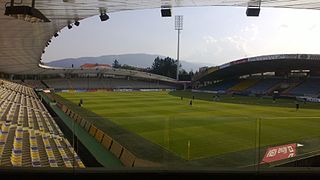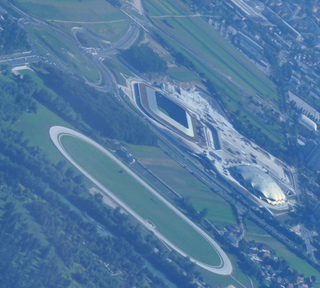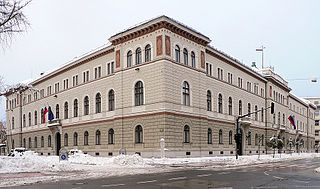
Squatting is the action of occupying an abandoned or unoccupied area of land or a building, usually residential, that the squatter does not own, rent or otherwise have lawful permission to use. The United Nations estimated in 2003 that there were one billion slum residents and squatters globally. Squatting occurs worldwide and tends to occur when people find empty buildings or land to occupy for housing. It has a long history, broken down by country below.

Ljubljana is the capital and largest city of Slovenia, located along a trade route between the northern Adriatic Sea and the Danube region, north of the country's largest marsh, inhabited since prehistoric times. It is the country's cultural, educational, economic, political and administrative center.

The Slovenia national football team represents Slovenia in men's international football and is controlled by the Football Association of Slovenia, the governing body for football in Slovenia. The national squad is under the global jurisdiction of FIFA and is governed in Europe by UEFA. It competes in the three major professional tournaments available to European nations: the FIFA World Cup, UEFA Nations League and the UEFA European Championship. Slovenia played its first official match in 1992, one year after the country gained independence from Yugoslavia. The majority of Slovenia's home matches are played at Stožice Stadium in Ljubljana.

Ljudski vrt is a football stadium in Maribor, the second-largest city of Slovenia. The stadium has a seating capacity of 11,709. It has been the home of NK Maribor since their formation in 1960, with the exception of a short period in early 1961. The stadium was originally the home of several other football teams based in Maribor, including Rapid and Branik. A prominent feature of the stadium is the main grandstand with a concrete arch, which is protected by the Institute for the Protection of Cultural Heritage of Slovenia as an architectural and historical landmark.

Zoran Janković is a Slovenian businessman and politician serving as Mayor of Ljubljana since April 2012. He previously served as mayor from 2006 to 2011.

Metelkova is an autonomous social and cultural centre in the city centre of Ljubljana, Slovenia's capital city. Formerly, the site was the military headquarters of the Army of the Austro-Hungarian Empire, then it became the Slovenian headquarters of the Yugoslav People's Army. It consists of seven buildings extended over a total area of 12,500 m2, which have been squatted since September 1993. The squat is named after nearby Metelko Street, which is named after the 19th-century Slovenian Roman Catholic priest, philologist, and unsuccessful language reformer Fran Metelko.

Lesbian, gay, bisexual, and transgender (LGBT) rights in Slovenia have significantly evolved over time, and are considered among the most advanced of the former communist countries. Slovenia was the first post-communist country to have legalised same-sex marriage, and anti-discrimination laws regarding sexual orientation and gender identity have existed nationwide since 2016.

Litostroj is a Slovenian heavy machinery manufacturer based in Ljubljana. Its products include mainly water turbines for hydroelectric powerplants. Most of the production is exported. It provided around 8000 MW of installed power worldwide. Around 150 of them are pumped storage. It has also designed around 1200 large cranes. They also manufacture forging and pressing machines.
Slovenia participated in the Eurovision Song Contest 1997 with the song "Zbudi se" written by Saša Lošić and Zoran Predin. The song was performed by Tanja Ribič. Slovenian broadcaster Radiotelevizija Slovenija organised the national final EMA 1997 in order to select the Slovenian entry for the 1997 contest in Dublin, Ireland. 13 entries competed in the national final where "Zbudi se" performed by Tanja Ribič was selected as the winner entirely by a public televote.

Stožice Sports Park is a multi-use sports complex in Ljubljana, Slovenia, that hosts basketball and football departments of sports club Olimpija Ljubljana. The sports park is located in Bežigrad District, north of the city centre and next to the highway bypass.
Trnovec is a settlement in the hills northeast of the town of Kočevje in southern Slovenia. The area is part of the traditional region of Lower Carniola and is now included in the Southeast Slovenia Statistical Region.

The Government Building and President's Office, also simply the Government Building or the President's Office, is a building in Ljubljana, the capital of Slovenia, that houses the Office of the President of Slovenia, the Secretary-General of the Government of Slovenia, and the Protocol of Slovenia. It stands at the corner of Prešeren Street, Erjavec Street, and Gregorčič Street in the Center District, next to the Cankar Centre. It is used for state and ceremonial functions, as well as for receptions and meetings with visiting foreign dignitaries and heads of state. Occasionally, exhibits take place there.

Stožice Stadium is a multi-purpose stadium located in Ljubljana, Slovenia. It was designed by Slovenian Sadar + Vuga architects and is the biggest football stadium in the country. It is one of two main stadiums in the city and lies in the Bežigrad district, north of the city centre. The stadium is part of the Stožice Sports Park sports complex.

Parliamentary elections were held in Slovenia on 4 December 2011 to elect the 90 deputies of the National Assembly. This was the first early election in Slovenia's history. The election was surprisingly won by the center-left Positive Slovenia party, led by Zoran Janković. However, he failed to be elected as the new Prime Minister in the National Assembly, and the new government was instead formed by a right-leaning coalition of five parties, led by Janez Janša, the president of the second-placed Slovenian Democratic Party. The voter turnout was 65.60%.

Poligon Creative Centre was a creative centre in Slovenia and the first and largest coworking space in Slovenia. It was a training ground for creative communities and self-employed operating in the field of creative economies, social entrepreneurship and culture in Ljubljana, Slovenia, and it was placed inside the former tobacco factory, Tobačna Ljubljana. The Slovenia Crowdfunding Initiative was based out of the center.
There are multiple groups and organisations within Slovenia which are or have been engaged in far-right political activity, and right-wing extremism. Their political activity has traditionally opposed and targeted socially progressive policies, and minorities, and espoused traditional ultraconservative and reactionary views and values. More recently, a rise in new, incipient alt-right groups has been noted, particularly as a reaction to the European migrant crisis. While far-right actors have been responsible for multiple acts of violent extremism in Slovenia it is a relatively minor issue in the country.
The 2020–21 Slovenian PrvaLiga was the 30th edition of the Slovenian PrvaLiga since its establishment in 1991. The season began on 22 August 2020 and ended on 22 May 2021.
Squatting in Slovenia is the occupation of derelict buildings or unused land without the permission of the owner. Housing was illegally built from the 1960s onwards and informal settlements have been set up by Romani people or poor immigrants. In the capital Ljubljana, there is the autonomous zone of Metelkova and the Rog self-managed social centre was evicted in early 2021.

Robert Golob is a Slovenian businessman and politician, serving as Prime Minister of Slovenia and leader of the Freedom Movement since 2022.
















